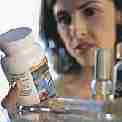Fungus & Yeast General Information
Treating Fungus And Candida Yeast Infections -- Important Facts About The Nature Of Fungus And Yeast
This page presents an overview of the world of fungus and yeast to help with a general understanding of the topic of fungal and yeast infections. We're just providing relevant information here, so it's not very long, and not very technical, but we also provide links to authoritative sources that can provide you with as much information as you can digest.
A few of the facts brought out here are important for understanding the CANDIDA TREATMENT PROTOCOL page.
Farther down this page is a table of the most common pathogenic fungi with some brief notes describing key characteristics. A version of this same table appears on our page FUNGAL AND YEAST LAB TESTS, with additional information about commercially available tests that can detect and identify these specific pathogens.
FUNGUS AND YEASTS -- AN OVERVIEW
Yeast and molds belong to a broader family of life called fungus, one of the very few "Kingdoms" of life (other Kingdoms are plants, animals, and bacteria). Mildew, bread mold, mushrooms, and toadstools are other types of fungi [plural of fungus, pronounced fun'ji]. The terms "yeast" and "fungus" and "mold" are often used interchangeably even though there are distinctions. The branch of science that studies fungus is mycology.
Some fungus feed off dead organisms, nature's garbage disposal, while other, parasitic fungus, feed off live organisms. These pathogenic fungus cause plant, animal, and human diseases such as athlete's foot, swimmer's ear, ringworm, dandruff, Valley Fever, fingernail and toenail infections, rosacea, and yeast infections.
 |
Typically, fungus sprout from a spore and grow as filaments termed hyphae [pronounced high'-fee] [singular: hypha, pronounced high'-fa], about 5-10 micrometers diameter. (It's not that there is a main body that produces hyphae, the fungus is the hyphae.) As the hyphae grow they branch repeatedly. Hyphae from individual fungus cells interconnect with hyphae from other cells, forming one large organism termed the mycelium [my-sill-ee-um]. The fuzzy mass of a bread mold is a good example. The whole thing is a single fungus -- cut it up into pieces and each piece keeps on living as a single fungus.
Hyphae extend at their tips, while drawing the protoplasm (the internal stuff of the cell) forward as they grow.
 |
Tip growth enables fungus to grow continuously into fresh zones of nutrients and also to penetrate hard surfaces such as plant cell walls, insect cuticle, your skin, etc. This is why fungus are so important as plant pathogens and as decomposer organisms. Fungal cells are strong and rigid. When given the chance, fungal hyphae can grow straight through human cells.
 |
Yeasts by comparison are unicellular with individual cells being spheroid as seen in the associated photo. Yeast cultures tend to grow in smooth and sometimes shinny masses. Whereas fungus reproduce by producing spores (the tiny spherules in the fungus photo), yeast reproduce by dividing (called "budding" or "fission") in a fashion similar to animal cells. Many of the yeast cells in the yeast photo can be seen in the process of division.
The basic cell construction of fungus is different from that of bacteria, plants and animals. Bacteria, plants, and fungus cells have a rigid cell wall; animals do not have a cell wall. The cells of all organisms have a "plasma membrane", what you might think of as the "cell wall" of our own cells. A plasma membrane is soft, pliable, and somewhat permeable so that nutrients and other necessary chemicals can get in and out of the cell. Bacteria, plant, and fungus cells are double-layered, having a cell wall that is like an outer, open weave scaffolding over an inner plasma membrane that keeps its internal stuff (protoplasm) inside where it belongs.

A major component of fungal cell walls is chitin [kite-in] (also found in the exoskeleton of insects), whereas the major component of plant cell walls is cellulose. Chitin and cellulose are chemically similar, and the fungal cell wall also includes cellulose, as well as zymosan, beta-glucan, and mannan. The cell wall structure is important in the discussion of treatments using enzyme supplements. See our ENZYMES discussion in the PRODUCT GUIDE.
The plasma membrane of fungal cells contain ergosterol, whereas animal membranes have cholesterol and plants have sitosterol and other 'phytosterols'. Several antifungal drugs (e.g. ketoconazole) used in human therapy act by blocking ergosterol synthesis. The antifungal antibiotics (e.g. nystatin, amphotericin B) combine with ergosterol in fungal membranes.
PATHOGENIC ACTIVITY
FUNGAL HYPHAE PENETRATE THROUGHOUT TISSUES

The spheroid form of the yeast cells is only half their life story. The other half is more sinister. Yeast can transform themselves and grow hyphae (or very similar structures called pseudohyphae). At 37 degrees C, which happens to be 98.6 F, body temperature, the insidious Candida grows hyphae that burrow into its food source (you). You can't just scrape off athlete's foot because it has grown deep into the tissues, and intestinal Candida infections aren't just clumps of yeast stuck to the inside of the intestines, the Candida yeast penetrates and permeates the wall of the intestine.
Read this from a site on remediation of mold contamination: "Hyphae can intertwine into the fibers of the substrate, penetrating the pores. As it consumes the substrate, it can also create it’s own route by dissolving pathways into the material. This is one of the reasons it is so difficult to kill and/or clean up mold on organic substrates. If you remove the surface growth, those bits of hyphae within the substrate are ready for re-growth upon the return of moisture."
FUNGAL SPORES ATTACK THE LUNGS
|
As can be seen in the fungi photo above, fungus produce astonishing numbers of spores, and most fungi have a mechanism of releasing the spores into the air. Consequently, many human fungal illnesses are contracted through the lungs. Other fungus and yeast may produce spores that are wet and sticky and may cling to insects, rodents, etc. as a mode of travel. Some yeasts, such as Candida, can generate a type of spore-producing hyphae called chlamydospores (cla-mid-o-spores) as seen in this photo.
FUNGI RELEASE TOXINS TO DIGEST THEIR FOOD
Whereas plants produce their own food by using the energy of the sun through photosynthesis, fungus have no such capability and so must eat other organism, such as plants and people. Fungus, yeast, and molds live in damp environments so that the hyphae can absorb nutrients that are dissolved in water. They absorb simple, soluble nutrients (sugars, amino acids, etc.) through their walls, and release extracellular enzymes (exoenzymes) into their environment to degrade more complex nutrients like cellulose that they cannot absorb. We eat our food and then digest it; fungus digest their food and then absorb it.
In addition to simple enzymes, such as those that break down starches into sugar, many fungus produce toxins (called mycotoxins) that aid the process in a variety of ways (perhaps to kill a bacteria first, then digest it). The spider injects a toxic venom having both a nerve agent and enzymatic action that paralyzes the victim and dissolves its insides, turning the victim's innards into a liquid that the spider can suck out. Fungus and yeast are similar to the spider -- they produce toxins and enzymes that can disable, kill, and dissolve their food sources so that the nutrients can be assimilated.
Some toxins, such as gliotoxin produced by Candida and Aspergillus (among others), disrupt the immune system. Gliotoxin inactivates a number of important enzymes, induces free radical damage, and is cytotoxic - it kills cells, especially white blood cells, by interfering with their DNA.

It should be no surprise, then, that fungal and yeast infections are frequently associated with "mysterious" illnesses such as Chronic Fatigue Syndrome and arthritis. The fungus is injecting its host (you) with toxins to dissolve and digest you. Even if the infection is localized, the toxic enzymes are transported by the blood stream throughout the body.
(Important note: it has been shown that NAC [N-acetylcysteine] inhibits gliotoxin induced cytotoxicity. See the PRODUCT GUIDE section on YEAST DEFENSE SUPPLEMENTS.)
THE MAJOR PATHOGENIC FUNGI
Like various kinds of virus and bacteria, fungus, mold, and yeasts are carried through the air (primarily as spores), and are omnipresent. Small amounts of yeast and other fungal organisms compose a normal part of the body's microflora. They normally are well tolerated by those with healthy immunity. If they increase in number, however, they create additional stress to the immune system, which can lead to an overgrowth. Conversely, those with weakened immune symptoms become susceptible to overgrowth of these (and other) microbial agents. Some, the true pathogenic fungus, can cause infections in otherwise healthy people.
Most cases of fungus and yeast infection in the United States are caused by Candida, especially C. albicans, and Aspergillus.
The following table lists the most common pathogenic fungi with some brief notes describing key characteristics. A version of this same table appears on our page FUNGUS AND YEAST LAB TESTS, with additional information about commercially available tests that can detect and identify these specific pathogens. Although there are other pathogenic fungi (actually about 200 other species), this table is keyed to the most significant pathogens and the tests used to detect them.
|
As revealed in the table, most pathogenic fungi are spread by airborne spores, and the common initial mode of infection is in the lungs. Notice that Aspergillosis may cause “allergic bronchopulmonary response” which mimics asthma.
ANTIFUNGAL PRESCRIPTION DRUGS
There are very few oral drugs available for treatment of yeast and fungus. They include itraconazole (Sporanox), ketoconazole (Nizoral), fluconazole (Diflucan), flucytosine (also called 5-F), Amphotericin B, nystatin, caspofungin (Cancidas), terbinafine (Lamisil), plus the recently approved voriconazole (Vfend) which is now the preferred treatment for Aspergillosis. See our page PRESCRIPTION MEDICATIONS for a discussion of these drugs.
A ROSE BY ANY OTHER NAME….
How to address a fungus: the scientific convention for naming organisms is to use the Genus and Species names together. In the case of Candida albicans, "Candida" is the name of the genus, and "albicans" is the name of the species. To avoid ambiguity, the species name is never used without the genus name. The genus name is capitalized and frequently abbreviated; the species name is written in lower case. The terms are written in italics. So, the correct form is either Candida albicans or C. albicans.
For those who like to memorize things, the hierarchy in the "Kingdom of Life" is: Domain, Kingdom, Phylum, Class, Order, Family, Genus, Species. A memory trigger is "Domineering King Philip Can Order Five Green Shirts".
INFORMATION SOURCES USED FOR THIS PAGE
Tom Volk's "fungus of the month" featuring Candida. Dr. Volk is Professor of Biology at U. of Wisconsin, La Crosse.
Doctor Fungus, a comprehensive technical resource in mycology.
The Microbial World on yeasts and yeast-like fungi.
A course overview of general biology and Kingdom Fungi by Dr. Mary Ann Reihman, Professor Biological Sciences, California State University, Sacramento.
Mycology Lecture Course by Dr. Jane Nicklin, School of Biological and Chemical Sciences, Birkbeck College, University of London.
Research article from the Electronic Journal of Biotechnology at.
Web article on the Physiology of Fungi by Italian medical student Daniele Focosi.
Lecture notes for Biological Sciences by Instructor Terence M. Murphy, U. of California, Davis.
Chapter on Basic Biology of Fungi by Garry T. Cole from "Medical Microbiology" Fourth Edition.
Slide Show from Affinity Laboratory Technologies "Do Mycotoxins Produced By Pathogenic Yeast and Fungi Contribute to Oral Toxicity and Potentially Systemic Diseases?" (slides 9 - 20).





